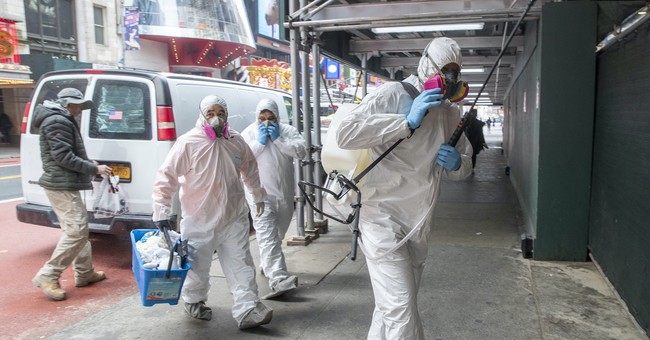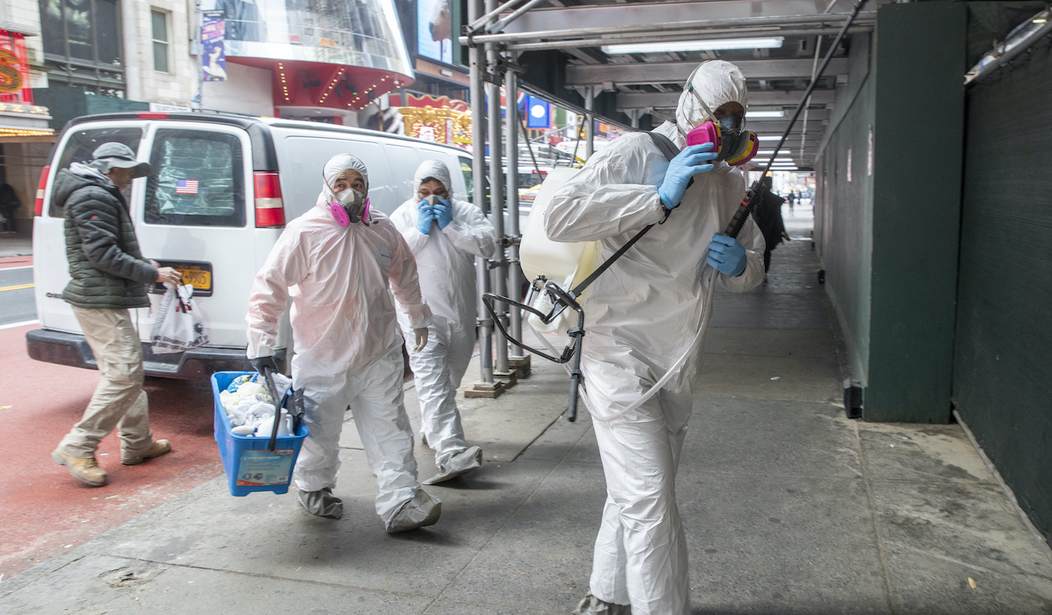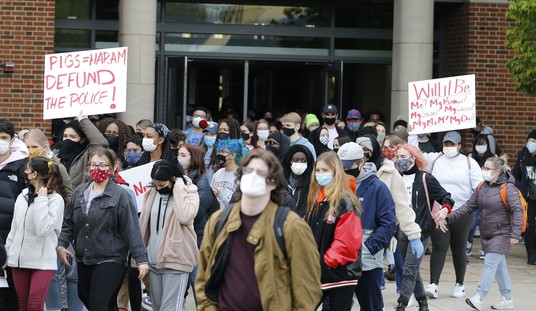
Men in protective gear arrive to disinfect a construction site on 42nd St., Friday, March 20, 2020, in New York. New York Gov. Andrew Cuomo is ordering all workers in non-essential businesses to stay home and banning gatherings statewide. “Only essential businesses can have workers commuting to the job or on the job,” Cuomo said of an executive order he will sign Friday. Nonessential gatherings of individuals of any size or for any reason are canceled or postponed. (AP Photo/Mary Altaffer)
Is it possible that the Chinese virus began circulating through the U.S. earlier than many of us had realized?
A 35-year-old man who had spent time in Wuhan, China visiting family arrived back in the country on January 15. Five days later, he became the first person to test positive for the coronavirus in the U.S.
Obviously, this man wasn’t the only person to visit relatives back in China over the holidays and return to the U.S. Many people were likely exposed to the virus in Wuhan before returning.
Consider the following two accounts I’ve heard this weekend.
On Friday, I received a reader email from a teacher. He is convinced that he and many of his colleagues had the coronavirus in February. He said so many students were sick that several nearby school districts closed. At first, they thought it was the flu, but those who went to the doctor tested negative for the flu. In fact, he had had a flu shot. The symptoms were consistent with COVID-19.
He added that he believes the coronavirus has already peaked.
I thought that was crazy…until the next morning, when a friend told me a similar story.
A friend of mine works in a large town hall in a suburb of a large city. This city is home to a prestigious university that is affiliated with a well-known area hospital.
He estimates that 33% of his town’s population is Asian. Many of them are affiliated with this university. They are undergraduates, graduate students, faculty. Others are doctors, nurses, residents, and administrators with the hospital. Add in to that mix all of the Asian restauranteurs, nail salon owners, retailers, and their families, and the number is in the thousands.
In December, many of them went back to China, Korea, and a host of other countries for Christmas break. They returned in mid-January for the resumption of classes, sharing planes, airports, buses, and restaurants.
He writes:
By the second week of February, my public building got hit with a strange illness that hit more than half of the staff. Most had mild to moderate symptoms, with the weird complaints ranging from slight, chronic headaches to fatigue to exhaustion. I myself felt woozie, dizzy, tightness in my chest. light-headedness, and thought I was going to faint every time I stood up.
I left work one day during the third week of February and went to my doctor. All he could find was an elevated temp of 99.5 and a slight abnormality in my EKG readings. He knew there was something wrong with me, but couldn’t figure it out.
If it was the flu, it didn’t feel like any flu I had ever had! I didn’t have a raging fever, no sweats or chills, or any other typical flu-like symptoms.
I also thought it strange that I was sent home with not only an antibiotic, but with an antiviral as well. I don’t think I’d ever been given both at the same time.
Many of us believe we were infected back in February.
This morning, former New York Times reporter Alex Berenson posted a text message thread in which he argues that “considerable evidence” exists that COVID-19 has peaked in the U.S. Fox News’ Brit Hume posted the thread to his Twitter page.
In his first tweet, Berenson is referencing the CDC’s introduction of new, more aggressive guidelines for the classification of coronavirus deaths. “COVID-19 should be reported on the death certificate for all decedents where the disease caused or is assumed to have caused or contributed to death.” This can often be a difficult call to make. For example, An Omaha, Nebraska newspaper reports that a man in his 80s recently died. Along with several underlying conditions for which he was already receiving Hospice care, he contracted the coronavirus. “Authorities determined that the COVID-19 infection was his leading, or “acute,” cause of death.” I posted about this here.
(Berenson covers the coronavirus 24/7 on his Twitter page.)
Following the number of hospitalizations is the key to following the path of the disease. As he says, “What is a more reliable metric than hospitalizations? We don’t know what we’re measuring with tests – whether we are measuring actual spread or the rise in testing. The death count lags and the @CDCgov has encouraged very loose criteria for attributing deaths to @COVID19.
Similar to The Federalist’s Sean Davis analysis of the actual number of hospitalizations vs. the projected number, which I posted about here, Berenson found the actual numbers were far less than the projected numbers.
Below, he writes that the number of hospitalizations has dropped in Florida.
So, take a look at this thread. Visit the Twitter page and form your own opinion.
Readers: If any of you believe you may have had the coronavirus early on, please let me know in the comments below or by email.
Thanks!
Elizabeth
Thread. https://t.co/O8T7PdaClD
— Brit Hume (@brithume) April 5, 2020
1/ Morning folks. Wondering why @CDCgov is using such aggressive rules for death counts? Look – there's considerable evidence #COVID infections have peaked in the US. Even the POTUS comments last night warning about this being the "toughest week" suggest as much (deaths lag)…
— Alex Berenson (@AlexBerenson) April 5, 2020
3/ Suppose the president is right. And this is the
"toughest week." And we average 1,500 deaths a day. That gets us to almost 20,000 deaths by April 12. By then the trend should clearly be down, I don't think it will be arguable…— Alex Berenson (@AlexBerenson) April 5, 2020
5/ No wonder @CDCgov is desperately trying to count every #COVID death. Because when people put those two figures together with what we have done to our economy, our kids, and society in the last month…
So as you watch the "toughest week" hysteria, remember what's coming next.
— Alex Berenson (@AlexBerenson) April 5, 2020













